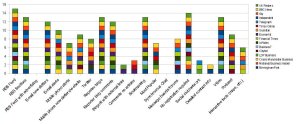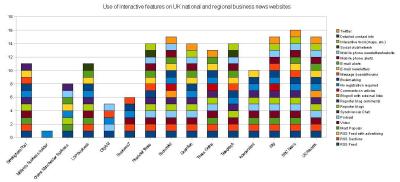The graph I created looking at the interactive features of UK business news websites has recieved a surprising amount of attention in recent weeks.
I had put it online to get some feedback, but it was picked up by Paul Bradshaw, who then wrote an article on it for Poynter Online. Then the study was replicated in Romania!
Now the World Editors’ Forum has contacted me and asked if I would let them publish it in their annual report!
Of course, I said yes but I want to wait to get my essay reviewed first before I give the final ok. Plus, I have changed the graph a bit and added another website (click on the graph to see the full-size version):
g
g
g
g
g
Being slightly on the nervous side, and having never published anything like this before, I’d appreciate anyone willing to give it a quick squiz to see if they see any glaring mistakes
I have had suggestions that I should by grouping the online tools (e.g. subscriptions, comments) by colour, but I have tried and this seems to confuse the graph. I would, if I had more time, like to regroup the categories into those that encourage “short tail” repsonses from users and those that encourage a “long tail” response. (Read more about these concepts on Paul Bradshaw’s description of the News Diamond).
Oh, and if people are more interested in the popularity of online tools amongst business news sites, this graph may be better (again, click to enlarge):
g
g
g
g
g



